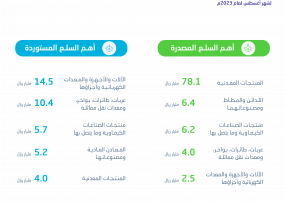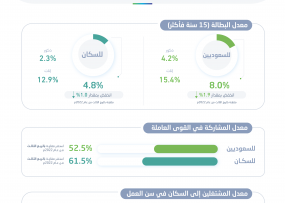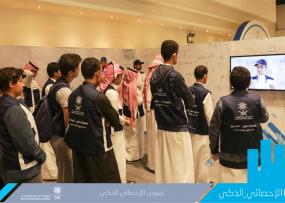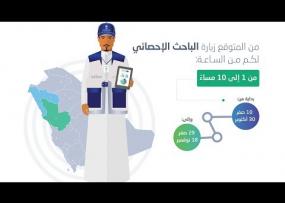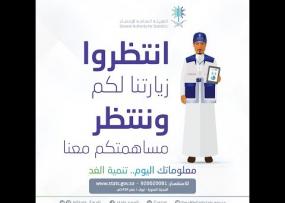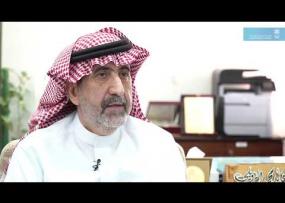Last update 21 / 09 / 2017
There are 23 terms and definitions used in Households and Individuals ICT Access and Usage Survey
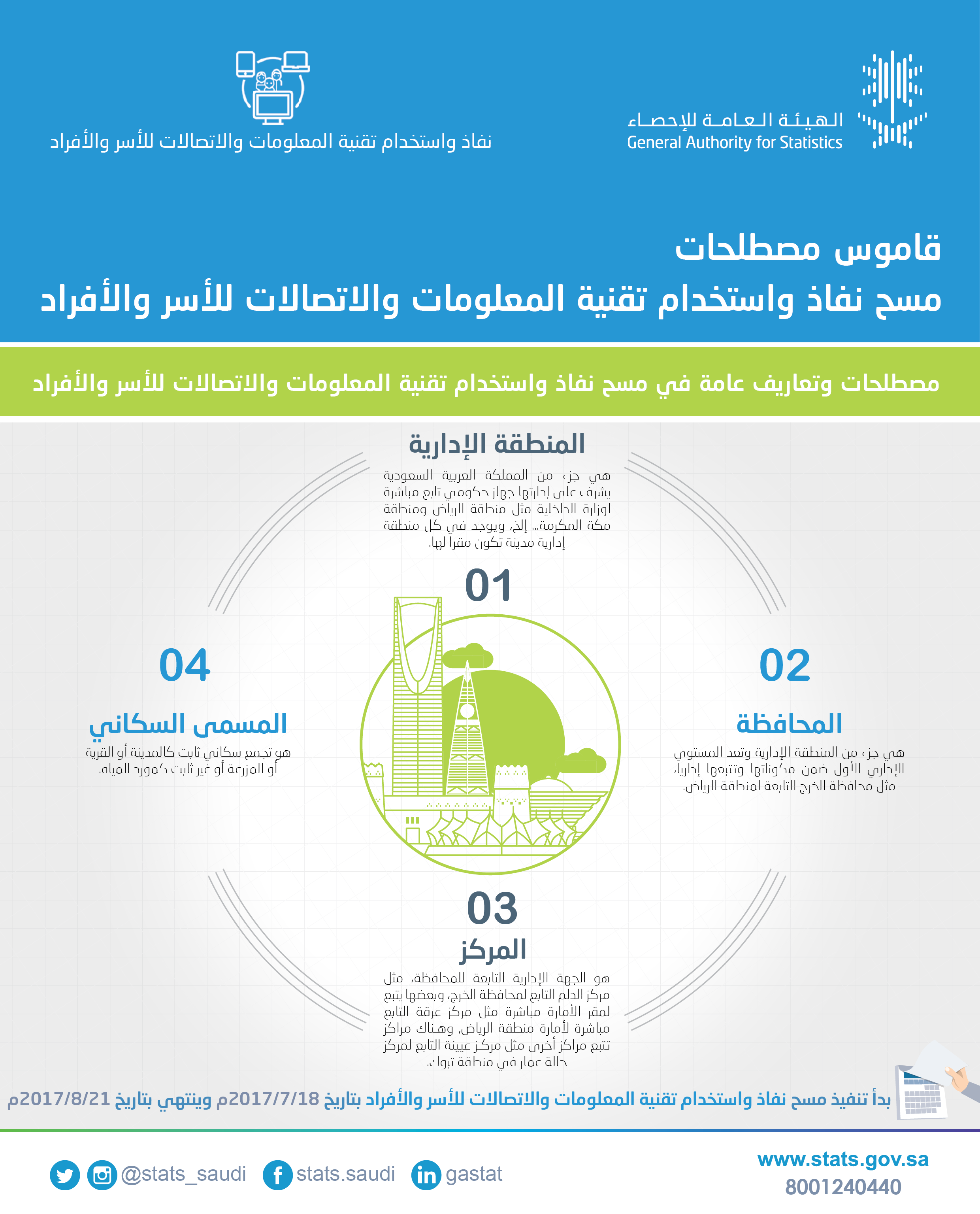
First: Definitions of terms used in the survey:
Administrative Region:
It is a part of KSA under the supervision of governmental body directly affiliated with Ministry of Interior such as Riyadh and Makkah. In each administrative region there is a city representing the region's base.
Governorate:
Part of the region, the first-level of the subdivisions and reports directly to region, such as Al-Kharj Governorate of Riyadh Region.
Municipality:
The administrative entity that reports to the governorate such as al-Dilam municipality of Al-Kharj Governorate. Others report directly to the Emirate headquarter such as Irqah which reports directly to Riyadh. Some municipalities report to other municipalities like Uyaynah of Halat Ammar in Tabuk region
Populated locality:
A static population cluster such as a city, village or a farm, or non-static like cluster around a water source.
Village:
A clustered human settlement with a commonly recognized name, and a population of no less than 50 thousands, or no less than 10 inhabited dwellings
Covered populated locality:
A static human settlement with a population of less than 50 thousand, or no less than 10 inhabited dwellings. This definition covers public and private work locations.
City:
For census purposes, 'city' refers herein to every locality with a municipality, or whose population exceeds 5,000 persons.
District
Part of a city that includes building, streets and roads, with a commonly recognized name.
It is usually surrounded with main streets dividing it from other neighborhoods.
Citywide, districts numbering starts with 001. and ends with the number of the last one in a city
Sector:
A statistical division used for statistical purposes in cities. It is a geographically clustered area which represents a part of a district, and usually enclosed by main streets. At the district level, sectors serial numbering starts with (01) and ends with the number of the last one in a district.
Block:
A geographical area surrounded by streets, and comprises a building or a number of contiguous buildings that are not separated by streets. It takes various shapes including a square, rectangle, circle or irregular-shaped space as in old neighborhoods. The block might also be an open space. At the sector level, blocks numbering starts with (001) and ends with the number of the last one in a sector.
Building:
A building is every structure; whether permanent or temporary, single- or multi-storey, with one or more rooms, and has one or more doors through which to access it. A building might and might not be inhabited; and it could be intended for housing, or for economic, social or religious purposes ... etc., such as a complex, a palace, a villa, a popular house, a tent, a hut, a shack, a shanty, a government body, a shop, a mosque… etc. Note that annexes to a building or a villa such as a garage or a shop are not counted as separate buildings. Likewise, bridges, power rooms, water pumps are not counted as buildings unless used for residential purposes during census period. In addition, buildings under construction are counted as buildings unless bases, foundations and walls are built.
Household:
As per the actual enumeration method, a 'household' refers to a person or a group of persons - with or without kinship binding them to one another - who share residence during the enumeration. The household includes:
• Saudi and non-Saudi nationals who usually live with the household but they were absent while the survey was conducted for being temporarily away; for example, businessmen, tourists, people who are travel for medication, students on scholarship beyond the borders of the kingdom.
• Individuals who stay with the household and were absent during conducting the research for the reason of being serving at work night shifts such as guards, doctors, nurses, pharmacists, and airport employees, in addition to household members who were at some public dwellings during the researcher's visit to the household.
• Servants, drivers and the like who are members of the same household.
• Family members who are on a trip in the Kingdom.
Head of the family:
It refers to the person regarded by the family members as its chief member. Usually, he is responsible for undertaking the responsibility of the household and his age must not be under (15) years old. If the family consists of children and their mother, and they are cared for by a relative who does not live with them, such a relative shall not be deemed as the head of the family, nor shall he be recorded as one of its members, since he shall be recorded with his own family. In this case, the mother shall be deemed as the head of the family.
Age:
It is the time period calculated between date of birth and date of visit. It is presented in years, regardless of months and days.
Nationality:
It is the individual's legal right of belonging to a particular country. It is usually defined by the passport the person already has, or has the right to obtain.
Supervisor's Area of Operation :
It consists of an administrative region and covers a number of areas for inspectors and researchers.
Inspector's Area of Operation:
It includes a number of counting areas. On average, it includes a sample of 25 households distributed among 5 researchers, serialized in the inspector's area of operation.
Researcher's Area of Operation:
It involves a number of counting areas selected for survey from (5 to 4) areas, based on each area's circumstances. Researchers are serialized within the inspector's area.
Counting area:
It is the smallest statistical division used in census 1431H that is composed of a geographical space and includes a number of buildings, dwellings and an average of (150) households of which a sample has been taken. The number of the sampled households is (28) in every numeration area.
Second: Main terms definitions used in the survey
1.Information and Communications Technology (ICT):
It refers to tools and ways to access information technology media, in addition to data recovery, storage, organization and data processing. Additionally, it refers to ways of data show and exchange through electronic and manual methods. Information technology tools include computers, scanners, digital cameras, phones, fax machines, CDs, and programs such as data bases and multi-media applications.
2.ICT Access and Usage
It is important to differentiate between what we mean by accessing ICT and using ICT. ICT access refers to the availability of such technology to the household.
On the other hand, ICT usage refers to the actual usage of ICT by one or more members of the household either inside the dwelling units or elsewhere.
3.Radio Device:
It is a device that receives radio signals using general frequencies such as: LW, AM, FM, SW. The radio can be a separate device or integrated with another device such as an alarm clock, Walkman, cell phone, or a computer.
4.Television Set:
Television is a device that receives TV broadcast signals using common access means such as over the air, central cable, or satellites. The television is usually a separate set or integrated with other devices such as computer or cell phone.
5.Fixed Telephone Line:
It refers to the telephone line that connects terminal user device (such as telephone or fax) to the public switched telephone network (PSTN) which has a special outlet at phone switch.
6.Computers:
The computer includes a desktop computer, laptop, or a tablet. It does not include devices that are equipped with integrated computerized tools such as smart televisions or smart phones.
• Desktop Computer:
A computer that is fixed to one place. User sits usually in front of the computer and uses the keyboard.
• Laptop:
A portable small sized computer that performs the same tasks as the desktop computer. It includes small computers such as "Notebook", but does not include tablet computers and other similar hand-held computers.
• Tablet:
A computer integrated in the touch flat screen. The user touches the screen instead of using the regular keyboard.
7.Cell Phone:
It uses a cellular technology that permits access to the public switched telephone network (PSTN). It includes digital and cellular symmetry technology such as Universal Mobile Telecommunications System (UMTS) 2000 of the 3rd generation, and 4th generation, and Advanced Mobile Systems.
Subscribers are of two types: Prepaid or postpaid (bill) subscribers.
• Smart cell phone:
A phone that enables the user to surf the Internet, check e-mail, open office files, and it contains a complete keyboard. It is also defined as the phone that uses one of the following operation systems: Windows phone, Symbian and its affiliated programs, Lennox and its affiliated programs, and BlackBerry. Smart phones do not differ from laptops or personal computers. All smart devices are composed of two integrated parts: hardware (the physical part), and Software (the programming operation system).
• Regular Cell Phone:
A phone that provides the user with the service of making or receiving phone calls, and sending SMS or media messages.
8.Blog:
Blog is a discussion site or an advertisements site on the world wide web and consists of posts ordered chronologically from the recent to the older.
9.Broadband:
A general term that refers to a signal or a communication device that uses a wider broadband in comparison with a regular signal or normal device. The movement capacity is higher when the broadband is wider. In data communications this term refers to the rate of transferring data which is not less than 256 Kbit/s.
10.Digital Subscriber Line (DSL)
A technology that connects high broadband to dwelling units and small economic establishments via regular copper phone lines.
11.Fixed Wired Broadband Network:
Refers to a technology with downloading speeds not less than 256 Kbit/s such as DSL, a cable modem, high-speed leased lines, fiber connections to buildings, power lines, and other fixed wired broadband.
12.Fixed Wired Narrowband Network:
Includes symmetric modem, Integrated Services Digital Network (ISDN), digital subscriber line (DSL) with speeds not less than 256 Kbit/s. In addition to other access ways that obtain announced download speeds less than 256 Kbit/s.
13.Kbit/s (Kbit/s or kbps):
Kilobyte per second (one kilobyte/second is 1000 bytes/second) A data unit = 1024 bytes. One byte represents 1 or 0 in Binary Digit system, or "true" or "false" in Logic system.
14.Mobile Broadband Network through USB:
Mobile Broadband Network of at least the 3rd generation, such as UMTS (Universal Mobile Telecommunications Service) via SIM (like a SIM card integrated in a computer) or a USB modem.
15.Mobile Broadband Network through hand-held device:
Mobile Broadband Network of at least the 3rd generation such as UMTS (Universal Mobile Telecommunications Service) via a hand-held device.
16.Broadband Satellite-Supported Network:
Broadband satellite-supported network with download speeds not less than 256 Kbit/s.
17.Land Fixed Wireless Broadband Network:
Refers to technology with speeds not less than 256 Kbit/s, such as WiMAX (Worldwide Interoperability for Microwave Access), and CDMA (Code Division Multiple Access).
18.USB Modem:
Universal Serial Bus, an external connectors that supports data transfer with rate of 256 Mbit/s - sec.
19.The Internet:
The Internet is a public and international computer web that provides access to communications services including world web. It transfers e-mails, news, entertainment, and data files disregarding the device used. Access is not restricted to computer solely, as it is available also via cell phone, tablet, PDA, games tools, and digital television, etc. Access is possible through fixed or mobile communication network.
20.Household Access Models to the Internet:
• Digital Subscriber Line (DSL)
Refers to connecting digital services through regular telephone network lines.
• Cable Modem connecting via Satellite:
Internet Access Technologies via satellites are the fastest in the realm of international network communications. This technology is the best and the most effective solution for many international companies that use the Internet in performing their work for the high speed of data transfer (receiving and sending data).
• Mobile Modems:
Mobile Broadband Networks of at least the 3rd generation, such as UMTS (Universal Mobile Telecommunications Service) via SIM (like a SIM card integrated in a computer) or a USB modem.
• Mobile package:
A mobile phone that serves as a public switched telephone network and uses cellular technologies that provide access to the network It includes digital and cellular symmetry technology such as Universal Mobile Telecommunications System (UMTS) 2000 of the 3rd generation, and 4th generation, and Advanced Mobile Systems. It also includes both of postpaid and prepaid subscribers.
• Other Fixed-broadband Internet types:
21.E-mail:
It is a tool that enables network local and international users to exchange messages, texts, and attachments from one computer to another inside or outside the establishment.
22.PO Box:
Mailbox is a metallic box that is hanged on the wall outside of the house or the establishment for the purpose of exchanging messages. It is also known as: An address dedicated for an individual or a given agency, and it is placed in a place called (post office). The owner or owners of the mailbox have the right to use it in sending and receiving messages, envelops, and parcel posts in return of paying a specific sum of money in case of renting the mailbox. The rent of the mailbox in such case shall be in accordance with the provisions indicated by the country to which the post office is affiliated.
23.National Address:
It is a unified national address all over KSA. The address is created by Saudi Post in accordance with standard technological specifications to facilitate identifying sites. This is accomplished through establishing a modern addressing communication system that represents the base for e-government applications and e-commerce activities. The address consists of three main parts: Postal Code, Building No., additional No.


